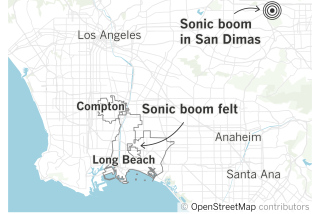Listening to the sun may improve space weather forecasts
- Share via
Sunspots, those dark regions on the surface of the sun whose high magnetic activity has ripple effects for Earthlings, seem to emerge and fade without warning. But now, by listening to the sounds the sun makes, scientists have managed to predict when a sunspot will appear up to two days beforehand.
The findings, published in Friday’s edition of the journal Science, could help solar physicists understand how to better predict solar flares and other space weather events that can harm astronauts and damage power and electronics systems on Earth.
The sun contains plasma, gas that has been superheated to the point that electrons are stripped from the nuclei of their atoms. The constant churning of that plasma on the solar surface generates sound waves, which travel toward the interior of the sun before they are bent back toward the surface. It usually takes an hour for sound waves to bounce from one point at the surface to the next, traveling roughly 60,000 to 125,000 miles in the process.
But a pocket of high magnetic activity deep within the sun, destined to rise to the surface and become a sunspot, is more buoyant than the churning plasma around it. So it floats toward the surface faster — and causes sound waves to move faster too. The stronger the sunspot, the more buoyant it is and the faster it rises to the surface.
A team of Stanford University researchers tracked sound-generated activity at different points on the sun’s surface and found that sound waves that would normally take an hour to cross from one point to the next traveled 12 to 16 seconds faster when a sun spot was emerging — a surprise, since the researchers expected to see perhaps only one second or so shaved off.
By monitoring sound waves about 37,000 miles below the solar surface, the physicists said, they can predict the emergence of a sunspot one to two days before it appears, depending on how large it is.
“It’s very exciting that we can detect them before they become visible,” said lead author Stathis Ilonidis, a graduate student studying solar physics at Stanford University. But he added that more data would be needed to show that their results hadn’t turned up false positives.
The findings could prove useful to scientists looking to tie sunspots to the space weather events generated days later. Because areas of high magnetic activity are closely linked to dangerous solar activity — from flares to violent coronal mass ejections — being able to understand that magnetic activity may help predict oncoming solar storms and allow people to prepare for them, rather like putting up storm windows in response to a hurricane warning.
“If an airline knew ahead of time, they could choose lower flights instead of having to dodge out of way,” said Philip Scherrer, a solar physicist at Stanford who was not involved in the study. Likewise, satellites could be switched into safe mode to protect the sensitive electronics inside. “There are a lot of things that can be done to mitigate the effect,” he said.
Coincidentally, the findings were released on the same day that NASA officials unveiled video tracking a coronal mass ejection from the sun that spewed matter all the way to Earth. Such a violent expulsion of billions of tons of highly charged gas can travel away from the sun’s corona at speeds of up to 3 million mph.
The images, captured by one of the two Earth-orbiting spacecraft that make up the Solar Terrestrial Relations Observatory, gave scientists an unprecedented view of how these clouds of gas change shape as they speed through the solar system.






